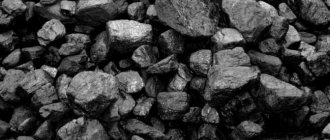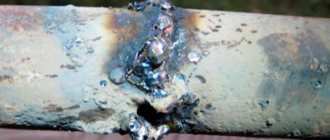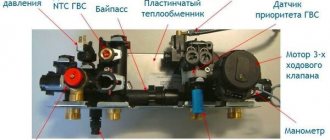Fuel
What is the advantage of a solid fuel boiler? Such a boiler can be heated not only with wood, but also with fuel briquettes (pressed sawdust, bark, shavings, peat), fuel pellets and coal.
Since firewood is the most common and cheapest type of fuel, owners of private houses and cottages often prefer it. When choosing firewood, you should take into account the calorie content of the wood species. The higher the calorie content, the less firewood will be needed to warm the room to the desired temperature.
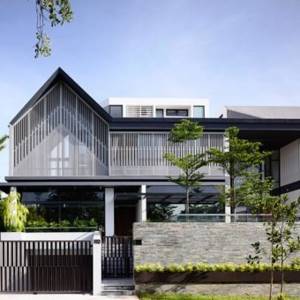
Ceramic chimney: advantages of use- Dry stream: perfect for any garden style

SHOWER CABINS: SIZE AND SHAPE
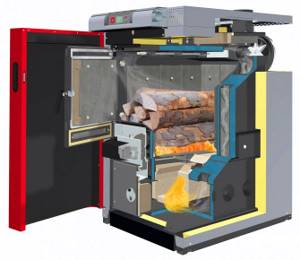
High demands are placed on the physical condition of firewood. First of all, they must have low humidity, since damp wood not only burns poorly and slowly, but also reduces the life of the boiler, which is not operating at full capacity. A room heated with raw wood warms up slowly and cools down quickly.
conclusions
There is nothing complicated about how to heat autonomous solid fuel heating boilers with wood. The design of most products is simple and straightforward. Having certain skills and following safety measures will allow you to operate a solid fuel boiler in normal mode.
Firewood in the firebox can be stacked in different ways, in a row and in the form of a well. Such layout methods are usually used in traditional boilers, fireplaces and conventional stoves. For pyrolysis boilers and long-burning units, the stacking of firewood must be done as tightly as possible so that there are no air gaps between the logs. A working boiler must burn almost all the fuel contained in it.
Before lighting a fire in the firebox, check for draft. If your match or paper flares up with a white flame, there is excessive draft in the chimney. If, on the contrary, the flame turns red, the draft is insufficient. The most optimal option for working draft, when the flame has a yellow tint. All nuances and subtleties should be taken into account when working with wood-burning boilers. Not only your comfort and coziness, but also the duration of uninterrupted operation of the heating device depends on how you handle heating equipment.
Firewood quality
The best firewood for a solid fuel boiler has always been oak firewood. Due to its high quality, these raw materials belong to the elite class. The cost of oak firewood is high, so it is not affordable for everyone. But such firewood is often indispensable when it comes to the taste of baked bread, pizza or other pastries. Here oak logs are simply irreplaceable.
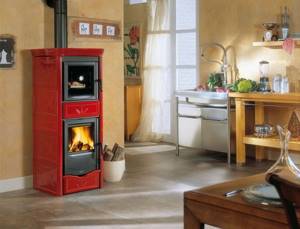
Let's look at the characteristics of firewood from different types of wood:
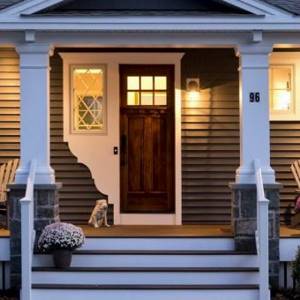
How to choose and install a profile for aluminum steps
Sunflower seeds
- Brawl Stars toys
- Oak: an elite, expensive variety. Burns powerfully, giving off a huge amount of heat;
- Birch: Best quality/cost ratio;
- Alder: excellent firewood, the house warms up quickly. In addition, the ancestors considered alder firewood to be “medicinal”, since in a house heated with its help, people were less likely to get colds;
- Pine: hot and aromatic firewood that burns well due to its resin content.
How to clean soot from a coal boiler
The composition of soot includes a non-combustible residue that turns into slag during the combustion process. An additional problem is that under the influence of high temperatures, low-quality coal leads to increased formation of condensation, an acid that can corrode the metal of the heat exchanger.
Boiler cleaning is carried out in several stages:
- It is necessary to remove the ash from the ash pan, a chamber located immediately under the firebox and which is a spacious box closed with a sealed door. The ash pan is removed and the ashes are poured out.
- Cleaning of slag is carried out with a special tool, the appearance of which resembles a curved awl. Sludge is removed around the perimeter of the heat exchanger and from the grate.
In addition to regular boiler cleaning, measures are taken to prevent increased soot formation. The main reason why the heat exchanger becomes clogged with soot is insufficient combustion temperature of the fuel. Layer-by-layer stacking of firewood mixed with coal can solve the problem of increased soot formation.
Heating a country house
If you use firewood as fuel, you should carefully study the operating features of a solid fuel boiler kazancompressor.ru. Maximum efficiency is achieved only with proper placement of logs.
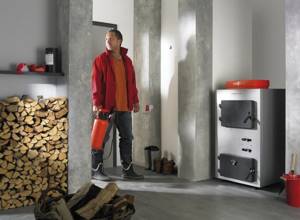
There are a number of developments where combustible raw materials are supplied to the core automatically. But the popularity of such devices is quite low, since they cost significantly more than conventional models. TT boilers, where firewood is supplied manually, are more accessible and easier to use. This type of technology can be divided into three categories:
- Long burning boilers;
- Pyrolysis;
- Classic.
Solid fuel boilers of various types. How to heat them correctly?
*
While the theoretical part is a bit clear, in practice the situation looks different. There is no general template for how to heat a solid fuel boiler with wood. Each solid fuel heating device has its own specifics and nuances. This concerns not only fundamental differences in the operation of units, but also the smoother choice of fuel. We mainly deal with three types of wood-fired boiler equipment. These are the following types of solid fuel boilers:
- pyrolysis type units;
- long-burning wood-burning boilers;
- classic heating devices.
In addition to the difference in operating principle, many heating devices differ in the way they load fuel. There are models with manual loading of firewood, as well as products in which this process is semi-automated.
Let's consider the situation with firewood for each type of heating device.
Pyrolysis boilers. What is the situation with firewood for boilers of this type?
Ignition of a pyrolysis type boiler is based on the principle of operation of the unit. Accordingly, a scheme for supplying fuel to the combustion chamber emerges from here. This type of heating device has two compartments. One contains materials for kindling: paper, wood chips, brown coal. The firewood itself is already stacked in another compartment. Combustion of the main fuel load occurs at a temperature of 4500C. To begin with, you can lay in an incomplete amount of firewood. After the flame burns, the remaining logs are laid.

Important! Pyrolysis boilers operate only on dry wood. The humidity of the fuel material should not exceed 7-8%. Otherwise, pyrolysis will not occur - the main feature of this type of boiler technology.
After the fire has ignited in the kindling chamber, the main work of the heating device begins. The high efficiency of the unit depends on the condition of the chimney. For pyrolysis boilers, it is necessary to have a cleaned and heated chimney.
How does a long-burning heating device work with wood?
*
Among the range of heating equipment, long-burning boilers occupy a significant place. These are the most efficient and productive devices, specifically designed for heating residential buildings. The main feature of such equipment is their enormous operating time. A well-functioning unit is capable of operating for a long time in normal operating mode from one load of firewood. The intervals between downloads are up to 8-12 hours. With foreign models you can achieve even better results.
Long-burning solid fuel boilers are not particularly fancy. They can be heated with ordinary wood, again dry. Paper and wood chips are used for kindling. Unlike other boilers, where combustion occurs from the bottom up, in these units everything happens the other way around. Fuel is added in even layers into the upper chamber. After the paper and small wood chips have ignited, we install a press equipped with an air distributor on the topmost layer of logs.
The press puts pressure on the wood, causing it to smolder slowly rather than burn with a bright flame. Due to this, a longer burning time for this type of equipment is achieved.
The sequence of kindling a conventional solid fuel unit is no different. Here, as is the case with newer, modern units, it is important to use dry firewood. Methods for laying firewood are determined by the size of the combustion chamber and the fuel combustion process itself. An air-type wood-burning boiler is nothing special in terms of fuel loading.
Classic solid fuel boilers are of the least interest, since this type of heating equipment is unpopular today.
Important! Under no circumstances should you use flammable and flammable substances such as gasoline, diesel fuel, and various chemicals when lighting solid fuel boilers.
*
Pyrolysis boiler
Connoisseurs of high technology may be interested in pyrolysis boilers, the cost of which, although higher than usual, is not comparable in productivity to traditional systems. The owner of such a boiler saves significant amounts on firewood, since the process includes the stage of burning gas released from solid fuel. With one stack of firewood, such a boiler can operate for more than a day.
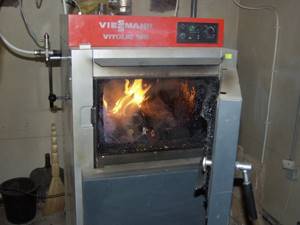
To properly heat a pyrolysis boiler, you should put a portion of wood chips and a large piece of dry paper into the scorching door, and firewood and a small amount of coal on top into the loading door. You should light a piece of paper, from which the combustion process will spread further. The door can be closed as soon as the wood chips ignite.

What to do if the coal in the boiler does not burn well?
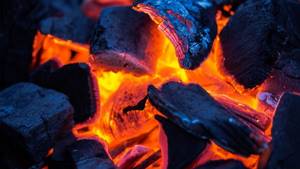
It is difficult to say in absentia why coal burns poorly or does not burn at all, because this happens for many reasons, but some of them are more common:
- reduction in draft due to clogging of the chimney and grate;
- using the wrong grade or simply low-quality coal;
- the boiler power is too high, which does not correspond to the area of the house;
- loading a large volume of coarse coal, without preliminary kindling;
- malfunction of the automatic forced air supply system;
- violation of the integrity of the structure (the flame often goes out + smoke).
In the case of the latter options, a boiler repair specialist will be required, but other problems can be completely resolved by proper operation and cleaning.
Long burning boiler
Maintenance of such equipment does not take much time: loading of fuel components is carried out once every 6 hours:
- Fill the fuel chamber completely with firewood;
- Use kindling from wood chips and a piece of paper;
- When the wood chips ignite, you can close the door and turn on the control unit.
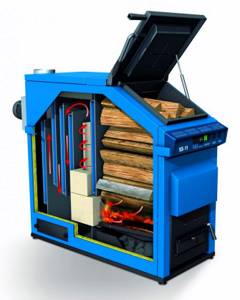
A heavy press is placed on top of the firewood to prevent strong burning.
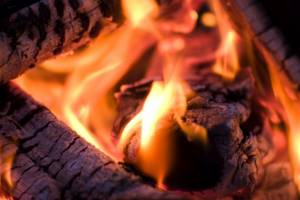
Preparing the stove for lighting
If the stove in a country house is used occasionally, before starting its operation, for safety reasons, it is necessary to exclude the presence of cracks inside the masonry.
Why are they dangerous? Through them, combustion products and carbon monoxide can enter the room, which must be removed outside using drafts. If such a defect is discovered, it must be eliminated before kindling by covering the cracks with a mixture of clay and sand. Otherwise, when heated, the cracks may increase in size even more. And this will lead to dangerous situations.
When inspecting the stove from the outside, we remove flammable objects away from it and clean it inside. We remove the ash and slag with a shovel, freeing the internal compartment. It is advisable to wipe the inner walls of the firebox with a dry cloth. If this is not done, then during kindling the dust will begin to burn, filling the room with an unpleasant odor.
The coal stove needs to be lit several times a day. The duration of one fire should not exceed two hours. For loading, it is better to use well-dried medium-fraction coal.
Note! Wet fuel produces steam when burned. It forms condensation, which settles inside the chimney
Mixing with soot, condensate forms coke, which gradually clogs the chimney passage, narrowing it. And this leads to problems with traction.
We invite you to familiarize yourself with Folk remedies for weeds: getting rid of grass once and for all
Do not use household waste or flammable liquids such as gasoline or kerosene to ignite coal. Do not leave the stove unattended while it is burning. This rule must be observed especially strictly if there are small children or animals in the house.
Tips for more efficient heating
If before refueling the boiler has recently been operating, and the chimney has excellent draft and has not yet lost its high temperature, it is enough to close the doors and, after turning on the control, record the desired temperature. After some time, you can remove the control unit and check whether the previously added part of the coal has ignited. If so, then it’s time to add additional combustion material. In this case, there is no need to close the slots in the front part of the grille.
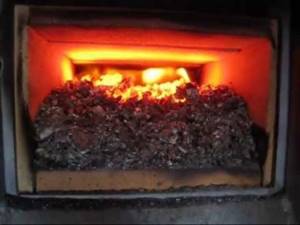
Rice. 2 Automatic coal boiler
If the chimney is not preheated, after setting the paper on fire, the lower door of the ash pan must be opened
Next, without turning on the fan, it is important to give the device some time to warm up using natural draft. After the combustion intensifies, its thrust will increase significantly, noticing this, you can close the door tightly and activate the control unit by turning it on
When the chimney has not been used for a very long time, or it is new, it is worth warming it up well before lighting it. To do this, it is enough to set fire to the paper while inspecting the chimney until the draft in the boiler increases.
How to speed up kindling

Many hunters give advice on how to quickly dry firewood. They saved more than one frozen life in extreme conditions. There are prepared woodpiles in the parking lots, only in the open air, where rain falls on them. Accordingly, during winter, they freeze and become covered with ice. But this does not prevent hunters from warming up. They use several old folk techniques:
- It is necessary to clear the lumber of snow.
- Chop into small slivers.
- Melt the unit, as we wrote earlier.
- Just throw two handfuls of coarse table salt onto the paper. It will absorb excess moisture.
- If you don’t have a newspaper at hand, take a piece of plastic or roofing felt. You will spend a little more time lighting these items.
- If this is not the case, then vegetable oil will help you. You can pour a tablespoon onto the wood chips. Or fill a liquid bottle with sawdust, shavings, newspaper or dry rags. And also put it in the fire.
- Use diesel fuel and gasoline. But there is no need to splash them into the combustion chamber. You need to soak a piece of rag in the liquid and place it next to the wood chips. Then you will avoid a fire hazard.
Of course, you can suffer for a long time with an old heater or stove, but in the end you will achieve results. But will it give you all the heat, will it be reliable in operation, will it withstand the load of wet wood? Before building a house with stove heating, you should contact specialized stores for advice.

Coal
Among various types of solid fuel, coal has the greatest heat transfer, which makes it one of the most efficient energy carriers in heating boilers. The amount of heat released during the combustion of coal is twice as high as that for wood and is about 7.5 kWh/kg.
Thus, to maintain a certain temperature of the coolant in the circuit, coal will require significantly less than other types of solid fuel.
The most efficient in terms of heat production is anthracite. It contains a minimum of moisture and impurities. However, it is very expensive and burns quickly, giving a very high temperature, which is simply not needed in heating boilers.
The advantages of coal are due to its physical and chemical properties:
- High calorific value. The main plus. With proper boiler design, a bucket of coal may well last for a day. The volume of fuel reserves purchased for the heating season is smaller, this is especially beneficial for small or densely built-up areas.
- Coal is not afraid of moisture. Although coal pits and sheds are built for storing coal, the inside of them does not need to be as dry as possible. When wet, coal retains its properties when it dries, since moisture does not penetrate inside.
- When burned, coal produces a very high temperature, which wood and its derivatives cannot produce. This allows the coolant in the circuit to be heated more efficiently with less fuel.
Unfortunately, coal is quite expensive. Even taking into account the fact that it produces more heat, there may not be any economic benefit from its use. Another thing is the location near famous coal basins. In these regions, coal is always cheaper and much easier to buy. In places of deposits, coal almost completely replaces firewood from use.
Fire safety! When dumping coal into large piles, there is a danger of spontaneous combustion. The fact is that a mineral extracted from the bowels of the earth oxidizes in the air, which leads to self-heating. When the critical point is reached, the coal ignites inside the heap - slow burning occurs.
To prevent self-ignition, coal is stored on a non-combustible substrate and poured in layers
You should also be careful when firing a boiler with coking coal, which is sometimes purchased by owners of plots located near enrichment plants. If used incorrectly, coke can produce such a high temperature that a steel and even cast iron furnace burns through, rendering the boiler inoperable.
Do not allow wood to burn too high
There are three wood burning modes: low, high and optimal.
When the mode is reduced, the firewood does not burn completely and produces a lot of soot. If it is higher, you waste firewood: part of the heat flies away through the chimney, since the heat exchanger and the room do not have time to remove it completely. This occurs in two cases: you use too much wood or supply too much air. It is necessary to reduce the volume of the bookmark or draft.
The best option is when the wood burns in the optimal mode: not weakly and not strongly. The easiest way to determine the combustion mode is to use a combustion indicator, which shows the current mode in real time. If the temperature of the flue gases is more than 320 degrees, then the firewood burns at high speed.
The combustion indicator determines the flue gas temperature and combustion mode in real time
Preheat the firebox
When wood starts to burn in a cold firebox, then:
- part of the heat is spent on heating the firebox, and not heating the room (as in the previous point).
- It is more difficult for them to flare up, since warm air overcomes the resistance of cold air in the chimney.
Basic firewood is best lit in a preheated firebox so that it does not waste extra energy heating the firebox and chimney. You can use the heat from the previous stack of firewood or pre-burn the prepared torches and paper in the firebox.
Features of briquette firing
Now let’s take a closer look at how to properly heat a solid fuel boiler with briquettes. Kindling is performed using the same method as when using coal. It is important to consider what kind of briquettes you burn with. When using “Euro firewood”, kindling is done with wood chips and special small briquettes for ignition. If they are missing, then you can simply grind ordinary briquettes. If peat briquettes are used, kindling is done with wood chips and small firewood.
The first placement of briquettes is carried out after the formation of a stable flame and sufficient heating of the boiler. Wood briquettes (“Euro firewood”) are first laid in a layer of 10-15 cm. When it flares up well enough, a layer of briquettes 15-20 cm thick is laid. The first layer of peat briquettes should be smaller - about 5-6 cm. In the future, they are also laid in thickness 15-20 cm. The blower must be closed with each new addition of fuel. It is opened only after loading of briquettes has been completed and the combustion door has been locked. In this case, you need to install the blower in the correct position to create optimal traction.

During the combustion process, it may be necessary to stir the briquettes in the firebox. You should not do this too often, so as not to cool the firebox. Mixing must be done carefully, avoiding sudden movements, to prevent briquette dust from rising into the air and entering the room.
It is important to decide which briquettes are best to heat a solid fuel boiler. “Eurofirewood” is made from plant materials. The basis of these briquettes is dry sawdust. They may also contain husks of cereals and seeds. This type of fuel differs little in its properties from ordinary firewood, but it provides higher efficiency and burns out more slowly. During combustion, a large amount of soot is not formed. These features make wood briquettes the best option for heating a home or bathhouse.
When burning, peat briquettes emit a lot of ash, which leads to rapid contamination of the grate and ash pan, and also pollutes the room in which the boiler is installed. Therefore, this type of solid fuel is not recommended for use for heating residential buildings. The advantage of fuel briquettes is their lower price. In addition, they burn out more slowly than wood ones.
Heating water supply boiler room
Heating installation
LLC DESIGN PRESTIGE > https://resant.ru/
Telephone
We provide installation services for heating and water supply systems for private country houses, dachas, and organizations. We supply equipment for work at discounts.
Heating: > https://resant.ru/otoplenie-doma.html
Installation, design, service repair. Heating by type: autonomous, water, private, wood, individual, gas, natural.
Water supply: > https://resant.ru/vodosnabzhenie-doma.html
Features of coal combustion
Let's look at how to properly heat a solid fuel boiler with coal. For kindling, wood chips approximately 5 cm thick are used, which must be laid out on paper. You need to put 3-4 logs with a diameter of 10-15 cm on top of the wood chips. After this, you need to set fire to the paper and close the firebox door, as well as cover the ash pan. In this case, the draft must be sufficient to ignite the firewood. If the boiler is equipped with a slide valve, then it is only slightly opened when lighting. If there is a thermostat, then it should be set to a temperature of 70-80 °C.

Coal can be added after 15-20 minutes of intense burning of the logs, when the chimney and the boiler itself are already sufficiently warm. In this case, you need to reduce the temperature set on the thermostat and fully open the gate valve. Before throwing coal, be sure to close the ash pit. The first layer of coal is laid with a thickness of 5-6 cm. After it burns out, a second layer with a thickness of about 15-20 cm is laid. Further layings also have this thickness.
It is also important what kind of coal to heat a solid fuel boiler. When using fine-grained fuel (up to 5 cm), it should be moistened by adding about a liter of water to a bucket of coal. The optimal fuel is large anthracite of a fraction of 6 cm. It does not require wetting. Water is added only if it is necessary to prevent overheating of the boiler.
